Catarina Moreira
Weakly Supervised Pixel-Level Annotation with Visual Interpretability
Feb 25, 2025Abstract:Medical image annotation is essential for diagnosing diseases, yet manual annotation is time-consuming, costly, and prone to variability among experts. To address these challenges, we propose an automated explainable annotation system that integrates ensemble learning, visual explainability, and uncertainty quantification. Our approach combines three pre-trained deep learning models - ResNet50, EfficientNet, and DenseNet - enhanced with XGrad-CAM for visual explanations and Monte Carlo Dropout for uncertainty quantification. This ensemble mimics the consensus of multiple radiologists by intersecting saliency maps from models that agree on the diagnosis while uncertain predictions are flagged for human review. We evaluated our system using the TBX11K medical imaging dataset and a Fire segmentation dataset, demonstrating its robustness across different domains. Experimental results show that our method outperforms baseline models, achieving 93.04% accuracy on TBX11K and 96.4% accuracy on the Fire dataset. Moreover, our model produces precise pixel-level annotations despite being trained with only image-level labels, achieving Intersection over Union IoU scores of 36.07% and 64.7%, respectively. By enhancing the accuracy and interpretability of image annotations, our approach offers a reliable and transparent solution for medical diagnostics and other image analysis tasks.
TagGAN: A Generative Model for Data Tagging
Feb 25, 2025Abstract:Precise identification and localization of disease-specific features at the pixel-level are particularly important for early diagnosis, disease progression monitoring, and effective treatment in medical image analysis. However, conventional diagnostic AI systems lack decision transparency and cannot operate well in environments where there is a lack of pixel-level annotations. In this study, we propose a novel Generative Adversarial Networks (GANs)-based framework, TagGAN, which is tailored for weakly-supervised fine-grained disease map generation from purely image-level labeled data. TagGAN generates a pixel-level disease map during domain translation from an abnormal image to a normal representation. Later, this map is subtracted from the input abnormal image to convert it into its normal counterpart while preserving all the critical anatomical details. Our method is first to generate fine-grained disease maps to visualize disease lesions in a weekly supervised setting without requiring pixel-level annotations. This development enhances the interpretability of diagnostic AI by providing precise visualizations of disease-specific regions. It also introduces automated binary mask generation to assist radiologists. Empirical evaluations carried out on the benchmark datasets, CheXpert, TBX11K, and COVID-19, demonstrate the capability of TagGAN to outperform current top models in accurately identifying disease-specific pixels. This outcome highlights the capability of the proposed model to tag medical images, significantly reducing the workload for radiologists by eliminating the need for binary masks during training.
PROMPTHEUS: A Human-Centered Pipeline to Streamline SLRs with LLMs
Oct 21, 2024Abstract:The growing volume of academic publications poses significant challenges for researchers conducting timely and accurate Systematic Literature Reviews, particularly in fast-evolving fields like artificial intelligence. This growth of academic literature also makes it increasingly difficult for lay people to access scientific knowledge effectively, meaning academic literature is often misrepresented in the popular press and, more broadly, in society. Traditional SLR methods are labor-intensive and error-prone, and they struggle to keep up with the rapid pace of new research. To address these issues, we developed \textit{PROMPTHEUS}: an AI-driven pipeline solution that automates the SLR process using Large Language Models. We aimed to enhance efficiency by reducing the manual workload while maintaining the precision and coherence required for comprehensive literature synthesis. PROMPTHEUS automates key stages of the SLR process, including systematic search, data extraction, topic modeling using BERTopic, and summarization with transformer models. Evaluations conducted across five research domains demonstrate that PROMPTHEUS reduces review time, achieves high precision, and provides coherent topic organization, offering a scalable and effective solution for conducting literature reviews in an increasingly crowded research landscape. In addition, such tools may reduce the increasing mistrust in science by making summarization more accessible to laypeople. The code for this project can be found on the GitHub repository at https://github.com/joaopftorres/PROMPTHEUS.git
Investigating Imperceptibility of Adversarial Attacks on Tabular Data: An Empirical Analysis
Jul 16, 2024Abstract:Adversarial attacks are a potential threat to machine learning models, as they can cause the model to make incorrect predictions by introducing imperceptible perturbations to the input data. While extensively studied in unstructured data like images, their application to structured data like tabular data presents unique challenges due to the heterogeneity and intricate feature interdependencies of tabular data. Imperceptibility in tabular data involves preserving data integrity while potentially causing misclassification, underscoring the need for tailored imperceptibility criteria for tabular data. However, there is currently a lack of standardised metrics for assessing adversarial attacks specifically targeted at tabular data. To address this gap, we derive a set of properties for evaluating the imperceptibility of adversarial attacks on tabular data. These properties are defined to capture seven perspectives of perturbed data: proximity to original inputs, sparsity of alterations, deviation to datapoints in the original dataset, sensitivity of altering sensitive features, immutability of perturbation, feasibility of perturbed values and intricate feature interdepencies among tabular features. Furthermore, we conduct both quantitative empirical evaluation and case-based qualitative examples analysis for seven properties. The evaluation reveals a trade-off between attack success and imperceptibility, particularly concerning proximity, sensitivity, and deviation. Although no evaluated attacks can achieve optimal effectiveness and imperceptibility simultaneously, unbounded attacks prove to be more promised for tabular data in crafting imperceptible adversarial examples. The study also highlights the limitation of evaluated algorithms in controlling sparsity effectively. We suggest incorporating a sparsity metric in future attack design to regulate the number of perturbed features.
DALL-M: Context-Aware Clinical Data Augmentation with LLMs
Jul 11, 2024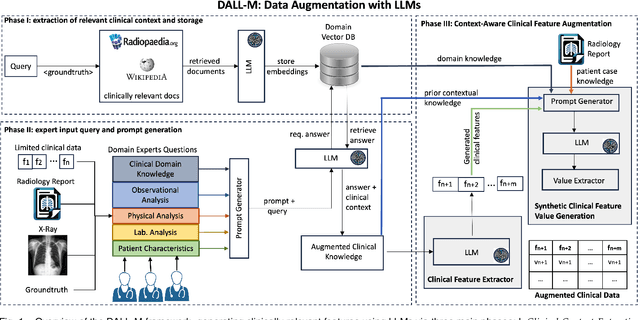


Abstract:X-ray images are vital in medical diagnostics, but their effectiveness is limited without clinical context. Radiologists often find chest X-rays insufficient for diagnosing underlying diseases, necessitating comprehensive clinical features and data integration. We present a novel technique to enhance the clinical context through augmentation techniques with clinical tabular data, thereby improving its applicability and reliability in AI medical diagnostics. To address this, we introduce a pioneering approach to clinical data augmentation that employs large language models (LLMs) to generate patient contextual synthetic data. This methodology is crucial for training more robust deep learning models in healthcare. It preserves the integrity of real patient data while enriching the dataset with contextually relevant synthetic features, significantly enhancing model performance. DALL-M uses a three-phase feature generation process: (i) clinical context storage, (ii) expert query generation, and (iii) context-aware feature augmentation. DALL-M generates new, clinically relevant features by synthesizing chest X-ray images and reports. Applied to 799 cases using nine features from the MIMIC-IV dataset, it created an augmented set of 91 features. This is the first work to generate contextual values for existing and new features based on patients' X-ray reports, gender, and age and to produce new contextual knowledge during data augmentation. Empirical validation with machine learning models, including Decision Trees, Random Forests, XGBoost, and TabNET, showed significant performance improvements. Incorporating augmented features increased the F1 score by 16.5% and Precision and Recall by approximately 25%. DALL-M addresses a critical gap in clinical data augmentation, offering a robust framework for generating contextually enriched datasets.
SelfReDepth: Self-Supervised Real-Time Depth Restoration for Consumer-Grade Sensors
Jun 05, 2024Abstract:Depth maps produced by consumer-grade sensors suffer from inaccurate measurements and missing data from either system or scene-specific sources. Data-driven denoising algorithms can mitigate such problems. However, they require vast amounts of ground truth depth data. Recent research has tackled this limitation using self-supervised learning techniques, but it requires multiple RGB-D sensors. Moreover, most existing approaches focus on denoising single isolated depth maps or specific subjects of interest, highlighting a need for methods to effectively denoise depth maps in real-time dynamic environments. This paper extends state-of-the-art approaches for depth-denoising commodity depth devices, proposing SelfReDepth, a self-supervised deep learning technique for depth restoration, via denoising and hole-filling by inpainting full-depth maps captured with RGB-D sensors. The algorithm targets depth data in video streams, utilizing multiple sequential depth frames coupled with color data to achieve high-quality depth videos with temporal coherence. Finally, SelfReDepth is designed to be compatible with various RGB-D sensors and usable in real-time scenarios as a pre-processing step before applying other depth-dependent algorithms. Our results demonstrate our approach's real-time performance on real-world datasets. They show that it outperforms state-of-the-art denoising and restoration performance at over 30fps on Commercial Depth Cameras, with potential benefits for augmented and mixed-reality applications.
* 13pp, 5 figures, 1 table
Generating Feasible and Plausible Counterfactual Explanations for Outcome Prediction of Business Processes
Mar 14, 2024Abstract:In recent years, various machine and deep learning architectures have been successfully introduced to the field of predictive process analytics. Nevertheless, the inherent opacity of these algorithms poses a significant challenge for human decision-makers, hindering their ability to understand the reasoning behind the predictions. This growing concern has sparked the introduction of counterfactual explanations, designed as human-understandable what if scenarios, to provide clearer insights into the decision-making process behind undesirable predictions. The generation of counterfactual explanations, however, encounters specific challenges when dealing with the sequential nature of the (business) process cases typically used in predictive process analytics. Our paper tackles this challenge by introducing a data-driven approach, REVISEDplus, to generate more feasible and plausible counterfactual explanations. First, we restrict the counterfactual algorithm to generate counterfactuals that lie within a high-density region of the process data, ensuring that the proposed counterfactuals are realistic and feasible within the observed process data distribution. Additionally, we ensure plausibility by learning sequential patterns between the activities in the process cases, utilising Declare language templates. Finally, we evaluate the properties that define the validity of counterfactuals.
MDF-Net: Multimodal Dual-Fusion Network for Abnormality Detection using CXR Images and Clinical Data
Feb 26, 2023Abstract:This study aims to investigate the effects of including patients' clinical information on the performance of deep learning (DL) classifiers for disease location in chest X-ray images. Although current classifiers achieve high performance using chest X-ray images alone, our interviews with radiologists indicate that clinical data is highly informative and essential for interpreting images and making proper diagnoses. In this work, we propose a novel architecture consisting of two fusion methods that enable the model to simultaneously process patients' clinical data (structured data) and chest X-rays (image data). Since these data modalities are in different dimensional spaces, we propose a spatial arrangement strategy, termed spatialization, to facilitate the multimodal learning process in a Mask R-CNN model. We performed an extensive experimental evaluation comprising three datasets with different modalities: MIMIC CXR (chest X-ray images), MIMIC IV-ED (patients' clinical data), and REFLACX (annotations of disease locations in chest X-rays). Results show that incorporating patients' clinical data in a DL model together with the proposed fusion methods improves the performance of disease localization in chest X-rays by 12\% in terms of Average Precision compared to a standard Mask R-CNN using only chest X-rays. Further ablation studies also emphasize the importance of multimodal DL architectures and the incorporation of patients' clinical data in disease localisation. The architecture proposed in this work is publicly available to promote the scientific reproducibility of our study (https://github.com/ChihchengHsieh/multimodal-abnormalities-detection).
Integrating Eye-Gaze Data into CXR DL Approaches: A Preliminary study
Feb 06, 2023


Abstract:This paper proposes a novel multimodal DL architecture incorporating medical images and eye-tracking data for abnormality detection in chest x-rays. Our results show that applying eye gaze data directly into DL architectures does not show superior predictive performance in abnormality detection chest X-rays. These results support other works in the literature and suggest that human-generated data, such as eye gaze, needs a more thorough investigation before being applied to DL architectures.
Immersive Virtual Colonoscopy Viewer for Colorectal Diagnosis
Feb 06, 2023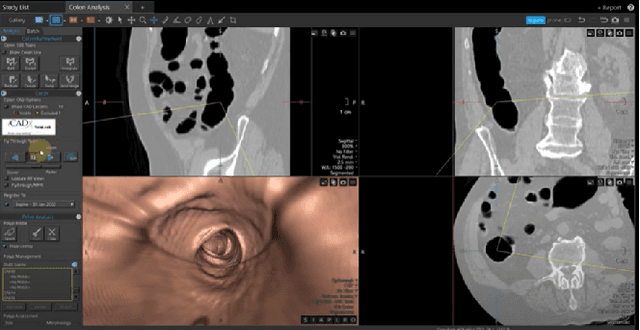
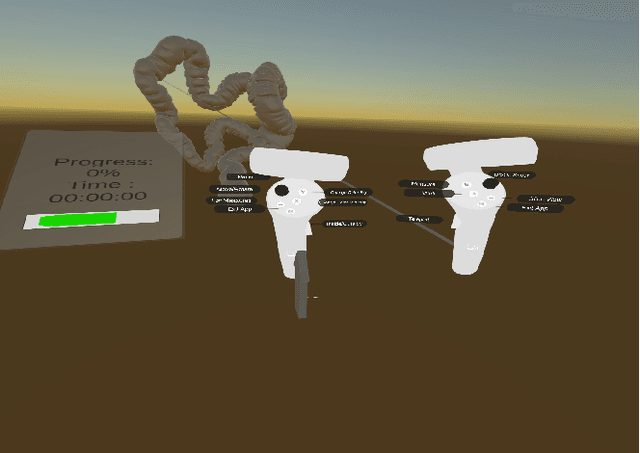
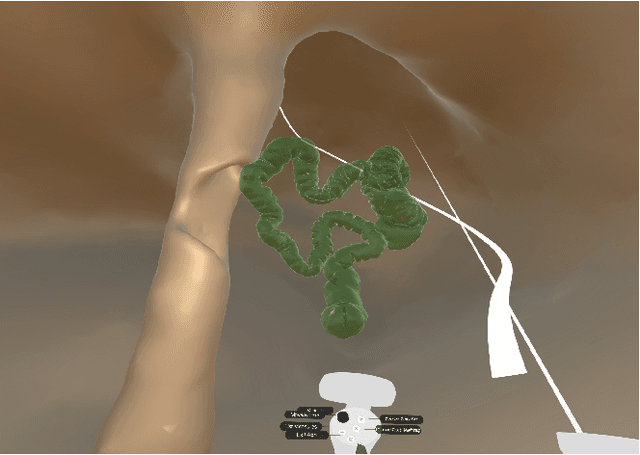
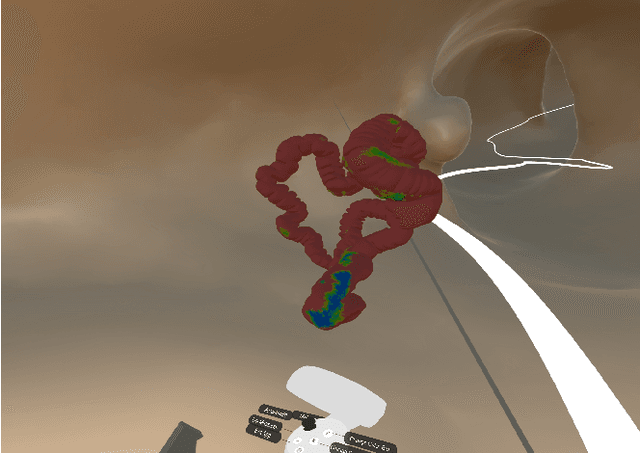
Abstract:Desktop-based virtual colonoscopy has been proven to be an asset in the identification of colon anomalies. The process is accurate, although time-consuming. The use of immersive interfaces for virtual colonoscopy is incipient and not yet understood. In this work, we present a new design exploring elements of the VR paradigm to make the immersive analysis more efficient while still effective. We also plan the conduction of experiments with experts to assess the multi-factor influences of coverage, duration, and diagnostic accuracy.
 Add to Chrome
Add to Chrome Add to Firefox
Add to Firefox Add to Edge
Add to Edge